As the February 8 general election approaches in about two weeks, the PTI is set to participate without its familiar ‘bat’ electoral symbol, having lost it due to the Election Commission of Pakistan’s (ECP) decision upheld by the Supreme Court. Despite the party’s efforts, PTI candidates will now compete as independents, each assigned a separate symbol. This symbolic loss, rooted in the party’s cricketing heritage linked to Imran Khan, has also resulted in the PTI forfeiting reserved seats for women and minorities.
The PTI contends that the removal of its iconic ‘bat’ could compromise the fairness of the election, making its candidates susceptible to horse-trading. To grasp the significance of electoral symbols and the challenges faced by the PTI in the upcoming polls, it is essential to understand the role of these unique pictorial identifiers assigned by the ECP to political parties and candidates.
What is an Election Symbol?
The Election Commission of Pakistan (ECP) distributes electoral symbols, distinctive visual representations, to political parties and candidates ahead of polls to facilitate easy recognition by their voters and constituents.
Typically, parties adopt enduring symbols, such as the PTI’s ‘bat,’ which pays homage to PTI founder Imran Khan’s illustrious past as the national cricket team’s captain. These symbols are prominently featured on ballot papers, allowing voters to cast their ballots by stamping their symbol of choice. Given the country’s literacy rate of under 40% among the 241 million population, visual symbols play a crucial role in ensuring unified recognition, especially in rural areas where the literacy rate is approximately 50%, as indicated by the 2022-23 economic survey.
Also Read: Election 2024: Overview, Preparations, ECP’s Mockup Test, and More Details
The complexity of the election process, involving numerous candidates and political parties, results in extensive options for voters on a single ballot paper. In the current election, 150 symbols have been allocated to political parties, with an additional 174 available for independent candidates.
Various political parties have distinct and popular symbols, such as the ‘tiger’ for the PML-N, the ‘arrow’ for the PPP, the ‘kite’ for the Muttahida Qaumi Movement-Pakistan, the ‘lantern’ for the Awami National Party, and the ‘book’ for the Jamiat Ulema-i-Islam-Fazl, among others. The complete list of allocated electoral symbols for political parties in this year’s election is accessible on the ECP’s website.
Reason Behind the Revocation of PTI’s Symbol
In December, the Election Commission of Pakistan (ECP) removed the PTI’s electoral symbol, citing technical grounds related to the party’s failure to conduct intra-party elections, a prerequisite for participating in the February 8 vote.
Challenging this decision, the party took the matter to the Supreme Court, which, on January 13, ruled against the PTI. This unexpected judgment left legal experts and political analysts in disbelief, describing it as a “blow to fundamental rights.”
Consequently, not only does Imran Khan face legal challenges, but his party also finds itself without a unifying electoral symbol. Instead, each of the hundreds of PTI candidates has been assigned individual symbols from the independent symbol list, including ‘donkey cart’ and ‘bowl.’
This situation introduces confusion for PTI voters and imposes additional costs for producing separate campaign materials, such as banners, for each candidate.
Also Read: PTI Reveals Plan C for Elections 2024 After ‘Batsman’ Rejection
Moreover, the PTI has temporarily lost its registered status with the ECP. As a result, the party’s candidates’ bloc is now ineligible for reserved seats in the National Assembly, a setback with significant implications. There are 70 seats reserved for women and religious minorities, allocated to parties based on the number of their candidates winning elections. Securing these reserved seats traditionally enhances a party’s position within the parliament.
Reason Behind the Revocation of PTI’s ‘Bat’
In December, the Election Commission of Pakistan (ECP) removed the PTI’s electoral symbol, citing technical grounds related to the party’s failure to conduct intra-party elections, a prerequisite for participating in the February 8 vote.
Challenging this decision, the party took the matter to the Supreme Court, which, on January 13, ruled against the PTI. This unexpected judgment left legal experts and political analysts in disbelief, describing it as a “blow to fundamental rights.”
Consequently, not only does Imran Khan face legal challenges, but his party also finds itself without a unifying electoral symbol. Instead, each of the hundreds of PTI candidates has been assigned individual symbols from the independent symbol list, including ‘donkey cart’ and ‘bowl.’
This situation introduces confusion for PTI voters and imposes additional costs for producing separate campaign materials, such as banners, for each candidate.
Moreover, the PTI has temporarily lost its registered status with the ECP. As a result, the party’s candidates’ bloc is now ineligible for reserved seats in the National Assembly, a setback with significant implications. There are 70 seats reserved for women and religious minorities, allocated to parties based on the number of their candidates winning elections. Securing these reserved seats traditionally enhances a party’s position within the parliament.
Possibility of ‘Halal horse-trading’ After Winning Elections
The PTI after loosing its iconic ‘bat’ symbol, attempted to form an alliance with PTI-Nazriati to adopt the ‘batsman’ symbol. However, the ECP swiftly intervened, preventing the use of symbols between parties.
These are the major consequences of the Supreme Court decision for #PTI taking away the BAT symbol and thus leaving no option for PTI affiliated candidates except contesting as independents:
1) Every single candidate will have to do an individual campaign with customized…— M. Jibran Nasir🎤 PS110 🇵🇸 (@MJibranNasir) January 13, 2024

